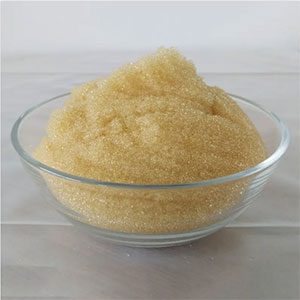Frequently Asked Questions
What is Strong Acid Cation Exchange Resin?
Strong acid exchange resin is a cation exchange resin with sulfonic acid group (-SO3H) as the main
exchange group, and can be reused.
Ordinary inorganic acids are used in the same way. The water softening resin type is a strong acid ion
exchange resin. Special catalyst type resins must be used as it is also related to the effect of
hydrogen ion release rate, pore size and degree of cross-linking on the reaction.
In industrial applications, the advantages of ion exchange resins are high treatment capacity, wide
range of decolorization, high decolorization capacity, removal of a wide range of ions, repeatable
regeneration, long service life, and low operating costs (although the one-time investment cost is
large) . Various new technologies based on ion exchange resin, such as chromatographic separation, ion
exclusion, electrodialysis, etc., each has its own unique features, and can carry out a variety of
special work that is difficult to do with other methods. The development and application of ion exchange
technology continues to grow rapidly.
How is Strong Acid Cation Exchange Resin stored and distributed?
1. Ion exchange resin contains a certain amount of water, and should not be stored in the open air. It
should be kept moist during storage and transportation to avoid wind-drying and dehydration, which may
cause the resin to be broken. If the resin is dehydrated during storage, it should be immersed in
concentrated salt water (10%) and then gradually diluted. It should not be put into water directly to
avoid rapid expansion and rupture of the resin.
2、When storing and transporting in winter, the temperature should be kept at 5-40℃, so as not to affect
the quality by too cold or too hot. If there is no insulation equipment in winter, the resin can be
stored in brine, and the concentration of brine is determined according to the temperature.
3, ion exchange resin industrial products often contain a small amount of oligomer and non-reactive
monomers, as well as iron, lead, copper and other inorganic impurities. When the resin is in contact
with water, acid, alkali or other solutions, the above substances will be transferred to the solution,
affecting the quality of the effluent water. Therefore, the new resin must be pre-treated before use.
Generally, water is used to make the resin fully swollen, and then 4-5% dilute hydrochloric acid is used
to remove inorganic impurities (mainly iron compounds), and 2-4% dilute sodium hydroxide solution is
used to remove organic impurities. If used for pharmaceutical preparations, it must be soaked in
ethanol.
What is Strong Acid Cation Exchange Resin used for?
Food Industry:
Strongly acidic cation exchange resin can be used in sugar, monosodium glutamate, wine refining,
biological products, removing the pigment of sucrose, enzyme extraction, separation and purification,
and removing bitterness in fruit juice.
Drinking water treatment:
There is a kind of resin in cation exchange resin, called food grade softening resin, which can
effectively remove the hardness in drinking water and make drinking water safer, usually used in water
purifier and water dispenser.
Pharmaceutical field:
Used for drug purification, decolorization, extraction of components in herbal medicine, can also be
used in the field of preparation for controlled release, transdermal drug delivery, positioning of drug
delivery and so on.
Industrial water treatment:
Cation exchange resin in industrial water treatment, can effectively reduce the hardness of raw water,
improve the quality of water production, so that the produced water to meet the user's needs, usually
used in boiler water treatment, semiconductor water treatment, electronics industry and other
fields.
Industrial wastewater treatment:
Industrial wastewater often contains a large number of harmful substances, such as acidic wastewater,
alkaline wastewater, cadmium-containing wastewater, chromium-containing wastewater, zinc-containing
wastewater, mercury-containing wastewater, fluorine-containing wastewater and so on, strong acidic
cation exchange resins can effectively remove the harmful substances, so that the produced water meets
the discharge standards.






